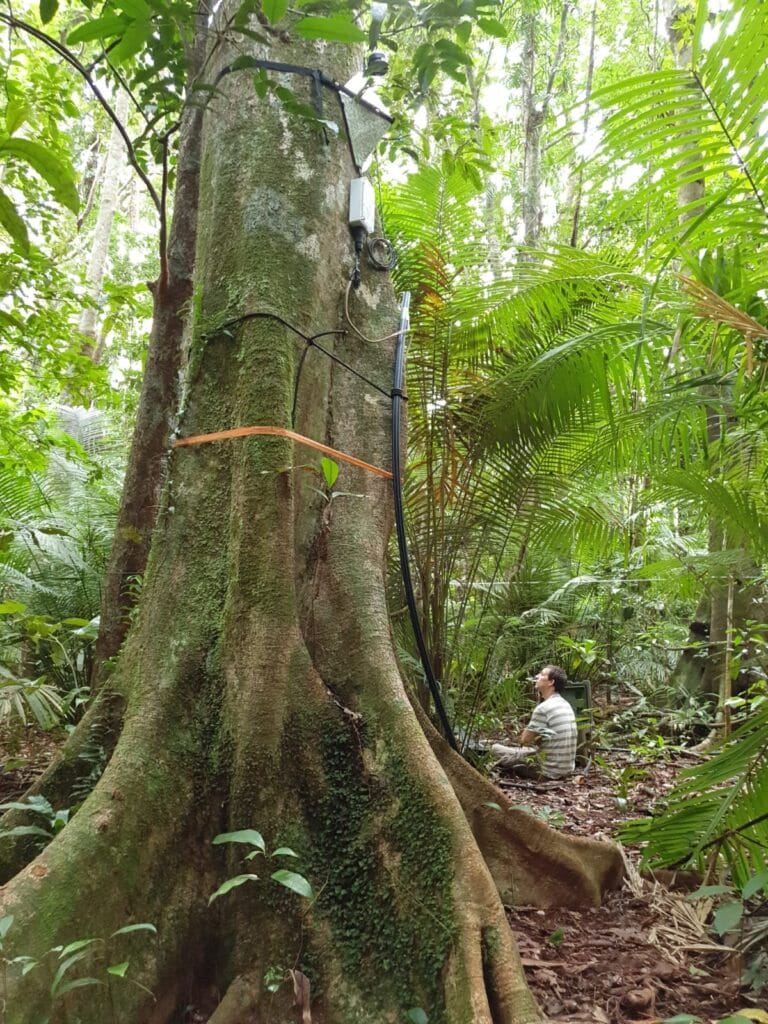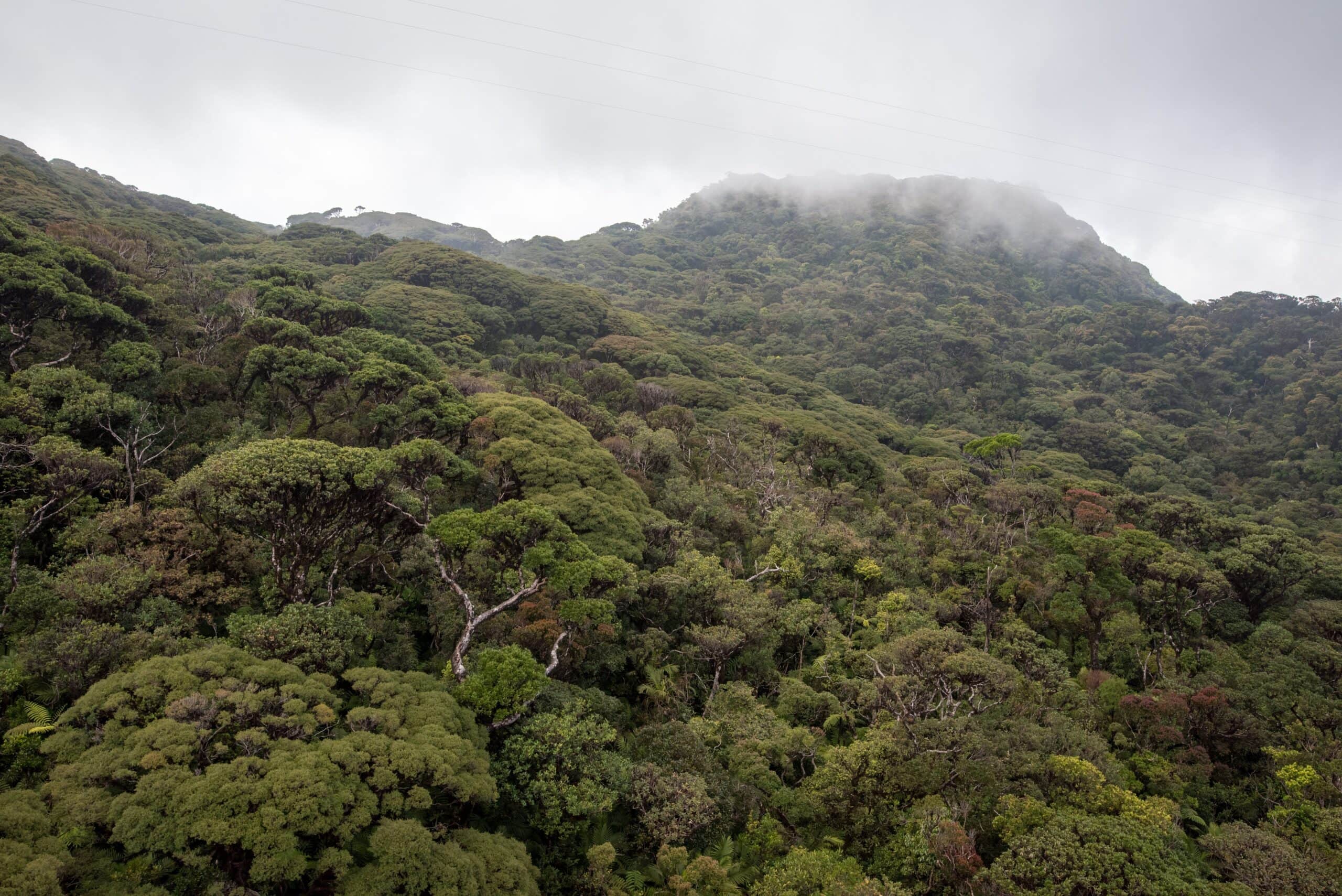“Forty-nine years of detailed inventories for a network of tropical forest plots encompassing a broad climatic gradient has absolutely no equal anywhere.”
Dr David Bauman, Oxford University
Image above: Australian tropical rainforests, far north Queensland. Credit Alexander Shenkin
TERN is now custodian of a remarkable long-term data set from CSIRO that was used by an international team of researchers, including from Australia, for a major study published in the prestigious journal, Nature in May 2022.
The findings of the remarkable study found that trees in Australian tropical rainforests are now dying at double the rate they were in the 1980s. Climate change brings warmer and dryer conditions. Rainforest trees are not used to that, so the physiological stress weakens and then kills them. The trees are dying at half their normal life expectancies.
This pattern is consistent across most of the species, and the authors find that the most likely underlying mechanism for this is the increasing drying power of the atmosphere caused by human-induced climate change. A recent study by the same authors had already shown that this same climatic factor was responsible for reductions in the pace of tree growth, with fast-growing species and those adapted to warm conditions being the most affected. Together, these results suggest that the forest composition may transition to slower-growing species and a generalised higher mortality rate. The consequences of this for wildlife are unknown.
Healthy forests have a certain capacity to absorb and mitigate human greenhouse gas emissions. Growing plants absorb carbon from the atmosphere, thus healthy forests can be carbon sinks. This means they remove and store carbon, slightly slowing human-caused global warming. However, forests suffering a high rate of tree death become carbon emitters. As dead plants decay, they release the carbon stored over their lifetimes.
This creates a devastating feedback loop. As conditions get warmer and dryer, the trees die, releasing carbon, exacerbating global warming, causing more warming and drying, degrading the forest still further. The pace of this cycle will probably accelerate.
Climate models regard forests as carbon sinks. The Paris Agreement carbon-reduction targets, intended to limit the average global temperature rise to well below 20 C above pre-industrial levels and to pursue efforts to limit the temperature increase even further to 1.50 C, were set according to the predictions of these models. Yet if dying forests become an unexpected additional source of atmospheric carbon, the targets may be insufficient to prevent such an increase. If warming does exceed 2oC, climate change could become catastrophic.
Furthermore, the observed high rate of early tree death may not be confined to Australia. It may be occurring all over the world’s tropical forests.
Dr David Bauman of Oxford University led a large international and multidisciplinary team of researchers, including members from The Smithsonian Environmental Research Center and the French National Research Institute for Sustainable Development. The team also included TERN-affiliated members from James Cook University and CSIRO.
“It was a shock to detect such a marked increase in tree mortality, let alone a trend consistent across the diversity of species and sites we studied.
A sustained doubling of mortality risk would imply the carbon stored in trees returns to the atmosphere twice as fast.”
Dr David Bauman, Oxford University
The collection of ecological data about forest growth is very labour-intensive and not easily automated, requiring up to 17 measurements per plot. Nevertheless, CSIRO researchers revisited the same plots, taking the same detailed measurements by hand, regularly for 49 years. So this has been the longest and most comprehensive tropical forest study in history.
Studying long-lived trees requires long-term data sets
“Our study was only possible thanks to the time depth of the unique CSIRO plot network. Forty nine years of detailed inventories for a network of tropical forest plots encompassing a broad climatic gradient has absolutely no equal anywhere.
This data set is of peerless importance to the study of how forests respond to climate change.”
Dr David Bauman, Oxford University
Studying long-lived species such as trees requires long-term data sets. Trees take considerable time to die. Also, the weak signal of change can be lost in the noise of many simultaneous processes. Long-term data is the only way to obtain a clear picture.
Therefore, key to this study is a superb long-term data set first established by CSIRO in 1970. CSIRO was studying tropical forest dynamics, and to do that, the organisation established a network of 20 study plots near Atherton in Queensland, approximately 80 km southwest of Cairns. The plots cover a wide area of forest across a sizeable altitude gradient, ranging from nearly sea-level to approximately 1200 metres. This alone makes the data set extraordinary. Furthermore, the data represent 509 tree species, from which the Nature team selected the dominant 75.
TERN-related sites in the Daintree Rainforest, Cow Bay, and Robson Creek Rainforest Supersite also provided more recent data from 2001 to 2012. The study also used monthly climatic data from the same period, obtained from the Bureau of Meteorology.

Securing and continuously growing the long-term forest data sets
The forests are a treasure to be conserved, but so are data illustrating how they change.
CSIRO has now ceased its inventory of the forest plots described in the Nature publication. However, conditional on its success in obtaining ongoing national research infrastructure funding, NCRIS-enabled TERN has plans for continuing the censuses of the invaluable network of old-growth tropical moist forest plots. Indeed, the first step in the planned transition of the inventory work to TERN was the deposit of the Nature study data into TERN’s repository where it is freely and openly available to researchers wishing to undertake further long-term studies of ecosystem dynamics.
- Read the Nature paper
- BBC Radio interview – Science in Action: Climate change: Why are the trees in our rainforests dying so quickly?
- Eurekalert: Rainforest trees may have been dying faster
- Oxford news website: Rainforest trees may have been dying faster since the 1980s because of climate change - study
- Smithsonian Environmental Research Center: Tropical Trees Are Dying of Dehydration Due to Climate Change
- The Conversation: Climate change is killing trees in Queensland's tropical rainforests
- JCU News: Rainforest trees have been dying faster since the 1980s
- The Guardian: Australia’s tropical rainforests have been dying faster for decades in ‘clear and stark climate warning’
- Daily Mail: Australia's rainforest trees are dying faster than ever, study finds
- ScienceAlert: Climate Change Has Been Killing Rainforest Trees For Longer Than We Realized
- Inverse: “Tropical forests may soon become carbon sources instead of carbon sinks.”
- The Canberra Times: Australian rainforests dying faster
- The Independent: Tropical trees are ‘dying faster’ in Australia with potential consequences for climate change







